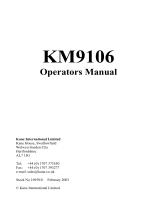
2
FUNCTIONS
• Measures: Flue temperature, Inlet temperature (Internal & External Sensor), CO, CO2
• Calculates: CO/CO2 Ratio, Efficiency (Nett or Gross), Efficiency (High Condensing), Excess Air, Losses
• Low flow detection
FEATURES
• Large 6 line display
• EOS Technology
• NOx Filtered
• Water Trap Indication
• High Altitude Compensation
TABLE OF CONTENTS
Functions .............................................2
Features ..............................................2
General Specifications ................................3
Important Safety Warnings ............................3
Symbols ..............................................3
Analyzer Overview ..................................4-5
Overview
...........................................6
Pre Test Checklist
...................................6
Setting Inlet Temperature
...........................6
Analyzer Connections
...............................6
Emptying & Cleaning the In-Line Water Trap
........7
Changing The Particle Filter
.........................7
Quick Start
..........................................7
Fresh Air Purge
......................................7
Measuring Flue Gases
...............................7
Display Parameters
................................8-9
Status Screen
.......................................9
Status Bar
..........................................10
Status Bar Icons ...................................10
Status Bar Icon Layout ..............................10
Status Bar Menu Options ............................10
Status Bar Options Table ............................10
Menu
...............................................11
Using the Menu ...................................11
Stored Logs Memory
................................12
Menu Options .....................................12
Viewing Stored Logs ................................13
Log View Menu Options .............................13
Navigating Stored Logs .............................13
Log Navigation Menu Options ........................14
Temperature Testing
................................14
Temperature Display ................................14
Viewing/Printing ...................................14
Printouts
...........................................15
Specifications
......................................16
Certification
........................................16
Where to Test
...................................17-18
What Results are Generally Acceptable
............18
What Results Are Generally Acceptable ................18
Typical Excess Air Level .............................18
Powering Off
.......................................19
Post Test
...........................................19
General Maintenance
..............................19
Cold Weather Precautions
..........................19
Replacing the Batteries
............................20
Annual Service & Recertification
...................20
Recertification Services
............................21
Returning Your Analyzer
............................21
Where to send your analyzer
.......................21
Other Important Factors Relating to Combustion
....22
Combustion Measurement Terms
...................22
Nett Temperature ..................................22
Draft ............................................22
Efficiency .........................................22
Combustion Efficiency Calculations ....................22
CO Air Free .......................................22
Disposal
............................................24
Cleaning
...........................................24
Storage
.............................................24
Warranty
...........................................24






















